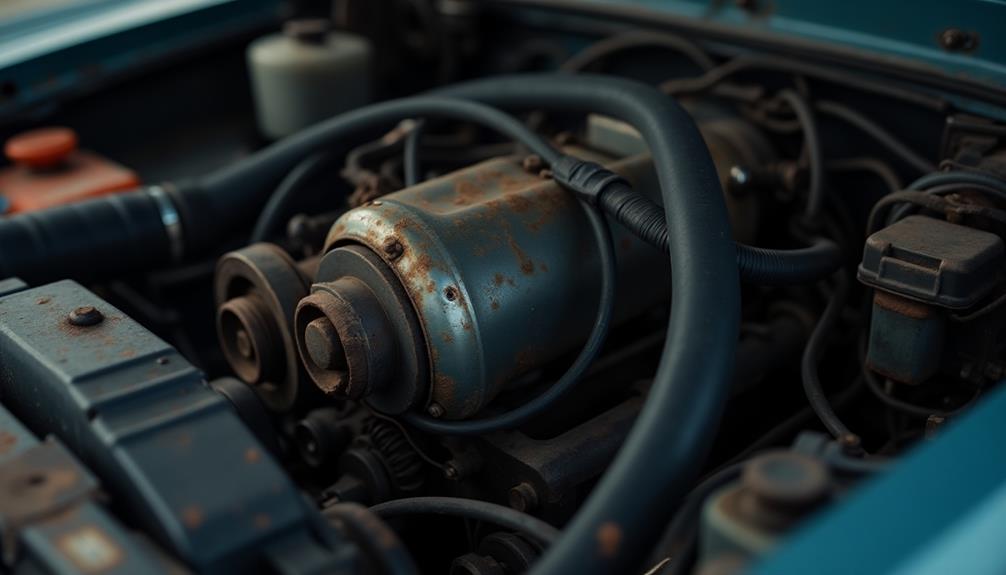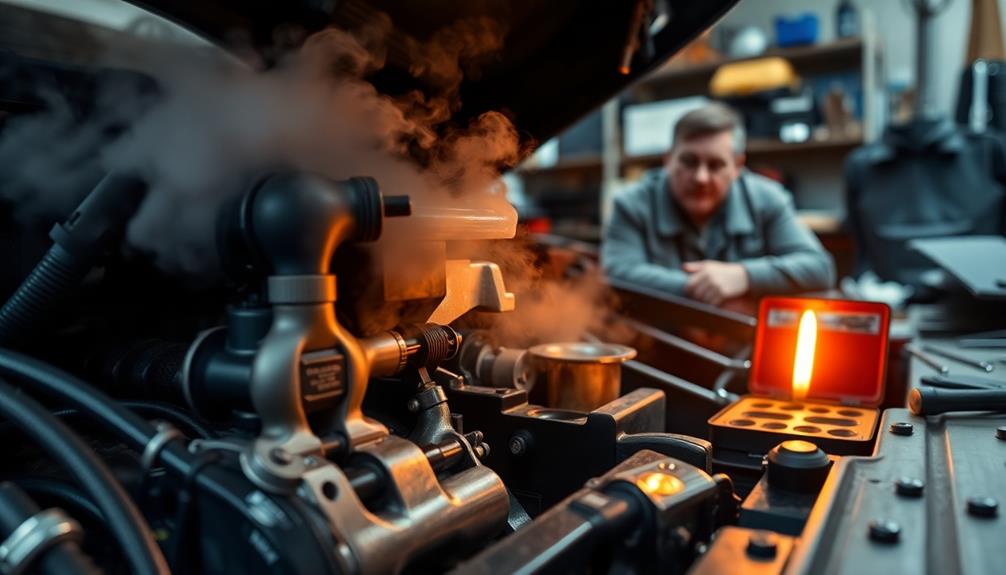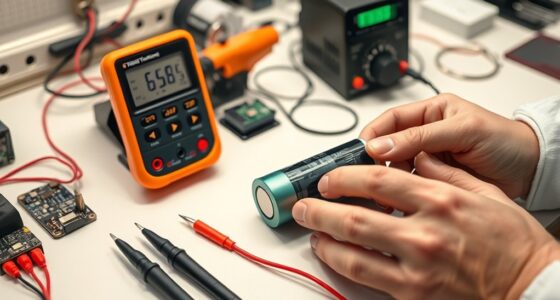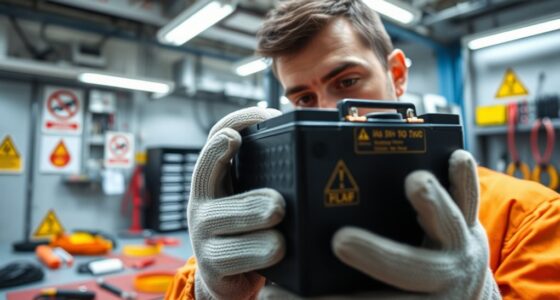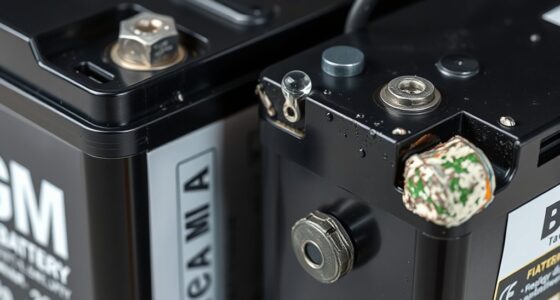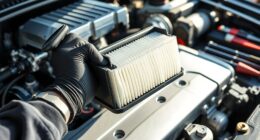If your car won't start and the battery isn't the issue, check a few other key areas. A faulty starter motor can cause a clicking sound, while fuel system problems, like a clogged filter or empty tank, can also prevent ignition. Mechanical malfunctions, such as a broken timing belt, should not be overlooked. Additionally, inspect electrical connections for corrosion and tightness. Ignition switch troubles or a dead key fob battery can create starting difficulties too. With so many potential culprits, understanding each factor can lead to a solution. Keep going to uncover more essential troubleshooting tips!
Key Takeaways
- A faulty starter motor can cause clicking noises, indicating issues that prevent the engine from cranking.
- Fuel system problems, such as a clogged filter or low fuel levels, can hinder engine start.
- Mechanical issues, like a damaged timing belt, disrupt engine turnover and require immediate inspection.
- Electrical problems, including corroded battery terminals or a faulty ignition switch, may prevent power transfer necessary for starting.
- Regular maintenance checks on the starter, fuel system, and electrical connections can help prevent starting difficulties.
Common Starting Problems
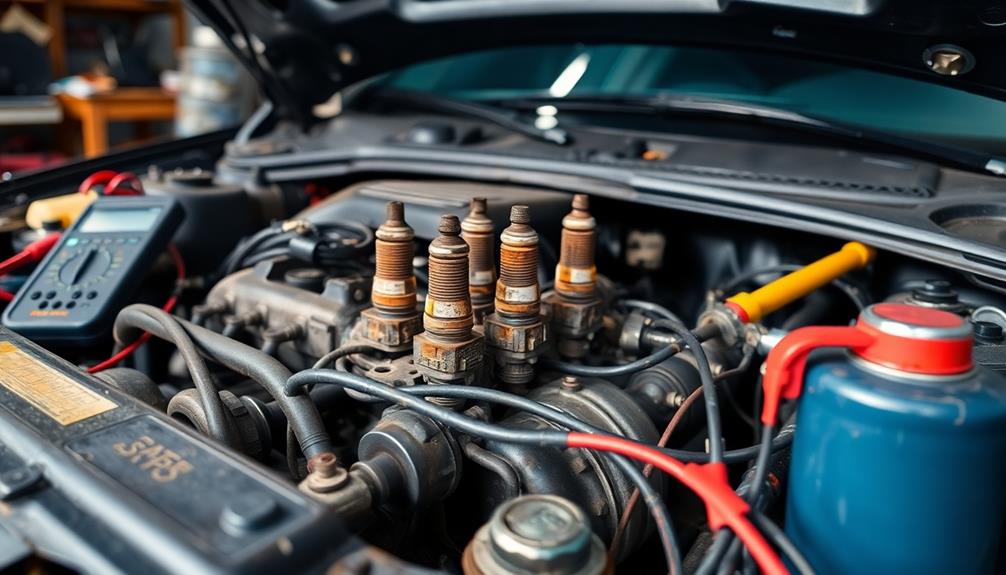
When your car won't start, it can be frustrating, but understanding common starting problems can help you troubleshoot the issue. One of the main culprits might be a faulty starter motor. If you hear a clicking noise when trying to start the engine, it's time to have it professionally inspected.
Another potential issue could be related to the fuel system. A clogged fuel filter or an empty tank can prevent the engine from starting, even if your battery is fully charged. Regular maintenance of your fuel system is vital to avoid these problems.
Mechanical issues, like a damaged timing belt, can also stop your engine from turning over, making regular inspections important.
Don't overlook electrical and wiring issues, either; corroded battery terminals or damaged ground wires can disrupt power transfer, leading to starting difficulties.
Diagnosing Electrical Issues
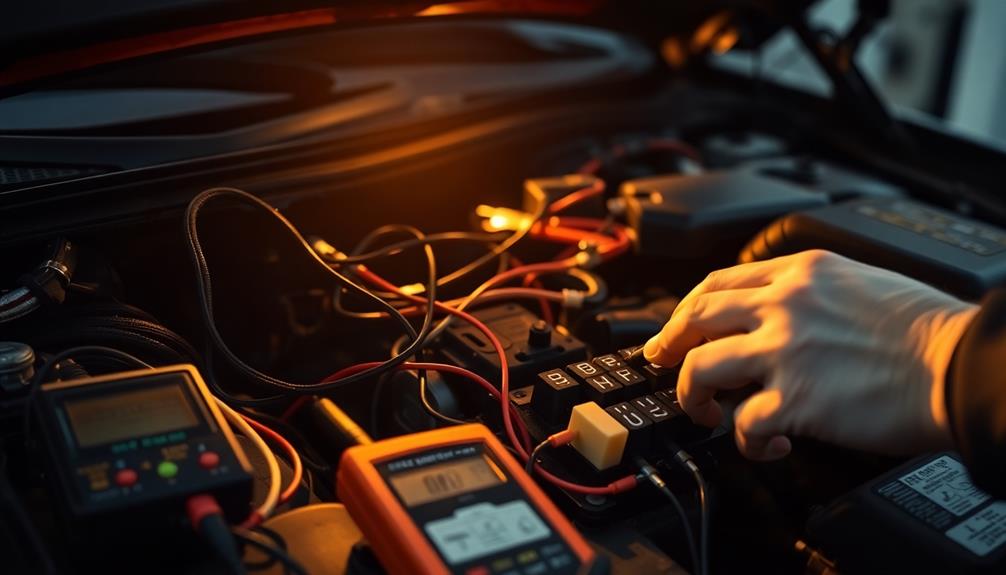
Identifying electrical issues is key to resolving starting problems in your vehicle. Start by checking the car battery and its connections. Look for corroded battery terminals, indicated by brown or white discharge, which can inhibit power transfer. Confirm the battery cables are tight and free from damage to guarantee effective electrical flow.
Next, consider the ignition switch. If it's jammed or the steering wheel is locked, you might need to wiggle the key to release the mechanism and allow for proper ignition.
Then, inspect the alternator; a faulty alternator can drain the battery, leading to starting issues. If your vehicle dies shortly after a jump-start, the alternator may need replacement.
Don't overlook ground wire problems, as these can cause hard starting and erratic electrical behavior. Symptoms include flickering dome lights and sporadic sensor failures, indicating potential wiring issues.
Fuel System Failures
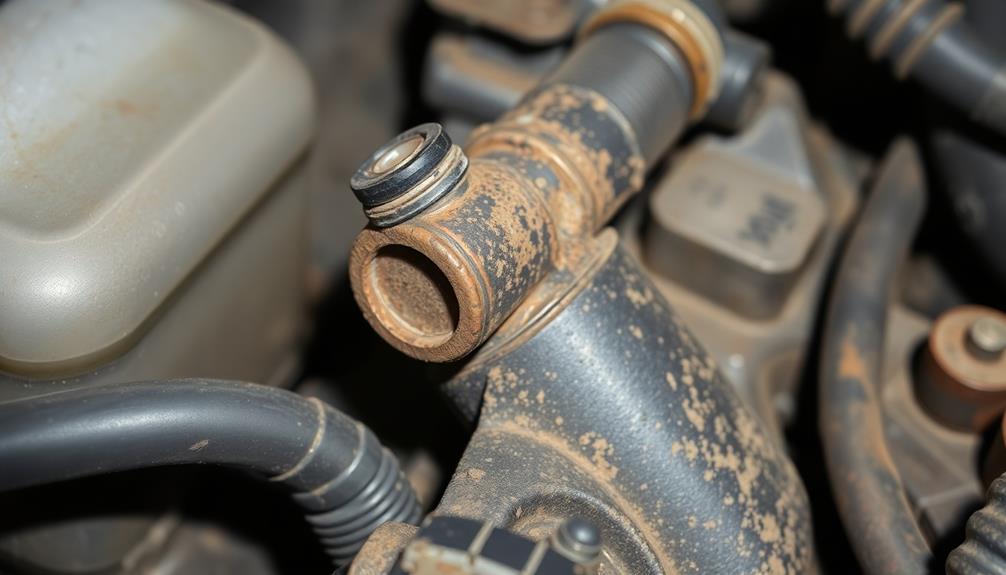
Fuel system failures can leave you stranded and frustrated, as they directly impact your engine's ability to start and run smoothly. Understanding common issues can help you avoid these situations. Here are four key factors to take into account:
- Clogged Fuel Filter: A clogged fuel filter can greatly hinder fuel delivery to your engine, leading to poor performance. Regular maintenance, similar to how heat pumps require routine checks for ideal air quality, is essential. Replace it every 30,000 miles to prevent engine damage.
- Low Fuel Levels: Running on empty can cause your engine to fail to start. Always verify your fuel gauge is working correctly and fill up before it gets too low.
- Fuel Line Freezing: In cold weather, fuel lines can freeze, obstructing fuel flow. Be prepared with warming methods or seek professional help if this happens.
- Regular Maintenance: Routine checks of your fuel system, including monitoring fuel quality and replacing filters, are vital for ideal engine performance. Neglecting these can lead to operational failures.
Just as noise levels of modern heat pumps have improved, being proactive about these fuel system issues can save you from the hassle of a non-starting car. Stay vigilant, and keep your vehicle in good shape!
Mechanical Malfunctions

While fuel system failures can lead to starting issues, mechanical malfunctions often play a significant role as well. For instance, if your timing belt is faulty, it can disrupt the timing of cylinder firing, preventing the engine from turning over. You might hear a clicking noise if the starter motor malfunctions, which indicates that electrical signals aren't effectively reaching the starter.
Additionally, ensuring your vehicle's ignition components are in good condition mirrors the importance of regular maintenance for safety equipment in wood stove operation, such as checking gaskets and seals on stove doors to prevent hazards safety equipment maintenance.
Engine mechanical issues, like a malfunctioning crankshaft, can cause the engine to crank quickly without starting, hinting at deeper internal problems that need a professional diagnosis. Additionally, a jammed ignition switch can prevent your engine from cranking altogether. Sometimes, you just need to wiggle the steering wheel to release the key.
Don't forget about issues with the fuel system. A clogged fuel filter can hinder fuel delivery, leading your engine to crank but not start due to inadequate fuel reaching the combustion chamber.
Ignition and Wiring Issues

Many drivers overlook ignition and wiring issues when their car won't start, but these problems can be just as essential as mechanical malfunctions.
Ignition systems and wiring play crucial roles in your vehicle's ability to start. Here are some common issues to check:
- Steering Wheel Lock: A jammed steering wheel can prevent the ignition key from turning. Try wiggling the wheel to free it.
- Key Fob Battery: A dead key fob battery may stop your vehicle from recognizing the key, leading to starting issues.
- Malfunctioning Immobilizers: If the immobilizer isn't working, even a functional ignition system may not start the engine due to a low key fob battery.
- Ignition Switch: A faulty ignition switch may fail to send necessary electrical signals to the starter motor, causing the engine not to crank.
Additionally, inspect for visible wiring damage near the engine.
Electrical issues, especially with ground wires, can impede the flow of electricity and prevent your car from starting.
Addressing these ignition and wiring issues can help you get back on the road.
Signs of a Bad Alternator
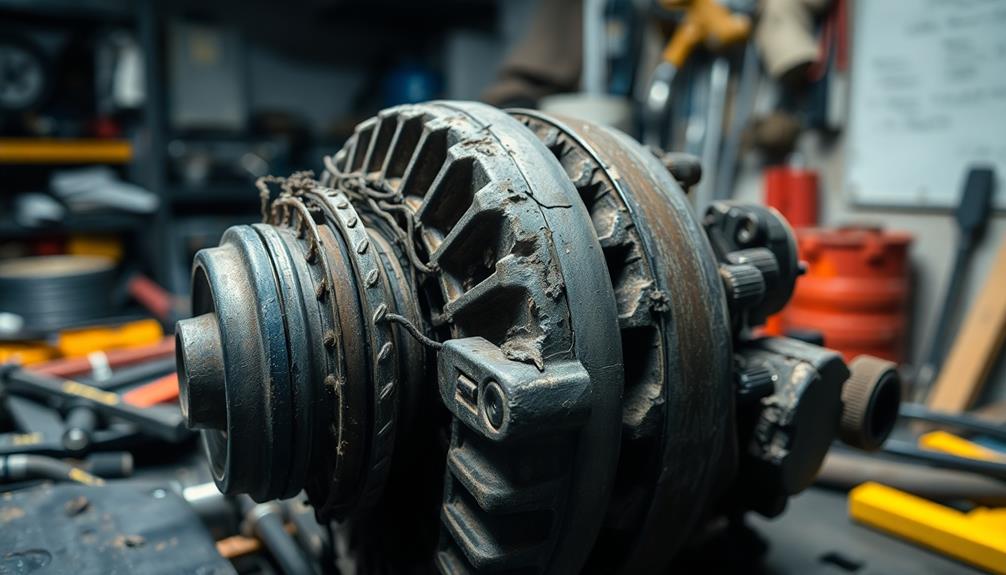
When your car struggles to start or stalls unexpectedly, it might be a sign of a bad alternator. The alternator is vital for keeping your vehicle's electrical system running smoothly, and signs of alternator failure can be alarming. Here are some indicators to watch for:
| Symptoms | What They Mean |
|---|---|
| Flickering Gauges | Your electrical system's power is unstable. |
| Dimming Headlights | Insufficient power supply to your lights. |
| Unusual Noises | Squealing sounds may indicate belt issues. |
| Stalling After Jump-Start | The alternator isn't recharging the battery. |
If you notice any of these signs, it's important to act quickly. A failed alternator can drain a new battery, making it ineffective for starting your vehicle. Additionally, if you hear a whine or fuzziness in your radio while revving the engine, it could point to deeper electrical system issues. Stay vigilant, and don't let a bad alternator leave you stranded! Regular inspection can save you from unexpected breakdowns.
Troubleshooting Steps
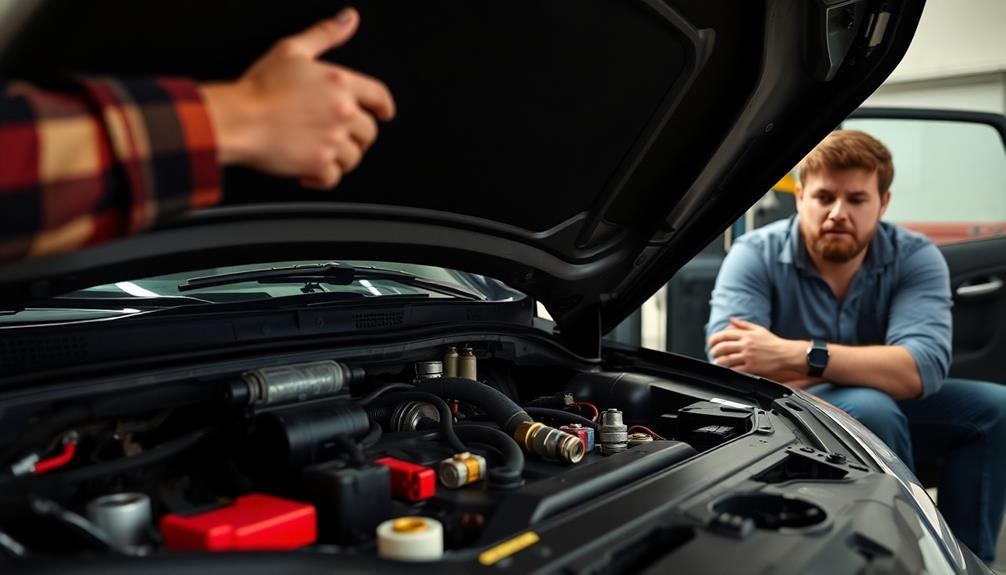
When your car won't start, it's essential to troubleshoot the issue methodically.
Start by checking the starter motor, as it plays a key role in cranking the engine.
Next, verify you inspect the fuel supply and electrical connections to pinpoint any potential problems. Ensure that there are no leaks or blockages in the fuel supply system, as these could affect engine performance. Check the electrical connections for any corrosion or loose wires, as faulty connections are common reasons your check engine light is on. Addressing these issues early can help prevent more serious, long-term damage to the vehicle.
Check Starter Motor Issues
Start by listening closely for sounds when you turn the key in the ignition.
If you hear a single click, it often points to a problem with the starter relay or electrical circuit rather than a battery problem.
On the other hand, rapid clicking noises usually indicate a flat battery or alternator failure, which can easily be confused with starter issues.
To troubleshoot starter motor problems, follow these steps:
- Check for Clicking Noises: A loud click may suggest a faulty starter motor. If that's the case, testing it with a voltmeter is vital.
- Listen for Engine Cranking: If the engine cranks but doesn't start, a faulty starter motor could be the culprit.
- Inspect Connections: Regularly check the starter motor connections for corrosion or loose wires, as poor connections can lead to starting issues.
- Test the Electrical Circuit: Verify the electrical circuit is functioning properly; a disruption could prevent the starter motor from engaging.
Inspect Fuel Supply Problems
After addressing potential starter motor issues, it's important to contemplate fuel supply problems that could prevent your engine from starting. Begin by checking your fuel gauge to verify there's enough fuel in the tank. An empty tank can be a simple yet common oversight.
Next, listen for the fuel pump's humming sound when you turn on the ignition. If you don't hear it, the fuel pump may not be functioning properly, which can keep your engine from starting.
Additionally, inspect the fuel filter. A clogged fuel filter can restrict fuel flow, leading to poor performance and potentially causing engine damage. It's wise to replace it every 30,000 miles.
In colder weather, fuel lines can freeze, leading to fuel delivery issues. Using fuel additives can help prevent this problem.
Here's a quick reference table for these key points:
| Problem | Symptoms | Solution |
|---|---|---|
| Empty Tank | Engine won't start | Refuel |
| Faulty Fuel Pump | No humming sound | Replace the pump |
| Clogged Fuel Filter | Poor performance | Replace filter |
| Frozen Fuel Lines | Engine cranks, no start | Use fuel additives |
| Inaccurate Fuel Gauge | Incorrect fuel level reading | Check gauge functionality |
Regular inspections can save you from frustrating starting issues related to fuel supply problems.
Examine Electrical Connections Thoroughly
It's crucial to examine electrical connections thoroughly, as overlooked issues can lead to frustrating starting problems.
Start by checking the battery cables for any damage or looseness. Corroded terminals can inhibit starting, so look for signs of brown, white, blue, or green discharge indicating corrosion. Regular cleaning of connections, similar to the maintenance needed for an air purifier, can also prevent electrical issues.
Next, verify all electrical connections, including ground wires, are secure and undamaged. Issues here can lead to hard starting and battery drainage.
Follow these steps to troubleshoot effectively:
- Inspect battery cables: Look for any fraying, cracking, or corrosion.
- Test the key fob battery: A dead fob can prevent the vehicle's immobilizer from recognizing the key, causing starting issues.
- Check gear position: Make sure the vehicle is in park or neutral; improper gear placement can stop the ignition system from engaging.
- Address any steering wheel jams: Gently wiggle the wheel while attempting to turn the ignition key, as a jammed wheel can prevent it from releasing.
When to Seek Help

When your car won't start, knowing when to seek help can save you time and stress. If you've ruled out a dead battery, consider the starter motor. If you hear a clicking sound or no sound at all, it's time to call a professional mechanic for diagnosis. Fuel system problems, like a clogged fuel filter or an empty tank, can also prevent starting. Check your fuel levels and filter conditions before seeking assistance.
If you hear rapid clicking noises, it might indicate a bad alternator or an electrical connection issue, which also requires a mechanic's expertise. Persistent starting issues that you can't identify should prompt you to reach out to a professional. They can perform a thorough diagnosis and provide you with the right solutions.
Here's a quick guide to help you:
| When to Seek Help | Signs to Look For |
|---|---|
| Starter Motor Issues | Clicking sound or no sound |
| Fuel System Problems | Low fuel levels or clogged filter |
| Mechanical Issues | Symptoms like engine noise |
Don't wait too long to get your car checked to avoid further complications!
Jump Starting Guidelines
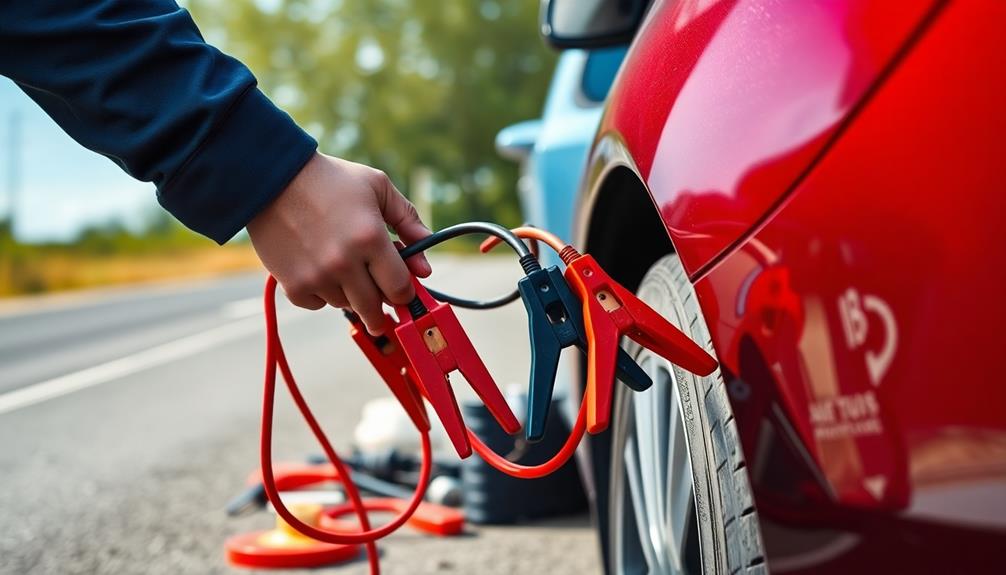
When you're jump-starting a car, it's vital to connect the cables correctly to avoid any mishaps.
Remember to prioritize safety by grounding the negative cable away from the battery to prevent sparks.
Once you've got everything hooked up, it's time to check the battery's condition and see if your car will start.
Proper Cable Connection
To jump-start a car successfully, proper cable connection is essential. Misconnecting your jumper cables can lead to electrical system damage or even personal injury. Here's how to do it right:
1. Inspect the jumper cables: Check for frays or damage. Damaged cables can cause unsafe connections.
2. Turn off both vehicles: Confirm both cars are off before connecting the cables to prevent electrical surges.
3. Connect the cables: Attach the positive cable (red) to the positive battery terminal of the dead battery first. Then, connect the other positive end to the working battery.
Next, attach the negative cable (black) to the negative terminal of the working battery, and finally, connect the other negative end to a grounded metal part on the dead vehicle. This prevents sparks near the battery.
4. Check for corrosion: Look at the battery terminals for any signs of corrosion. Clean these off to confirm good electrical contact.
After successfully jump-starting the car, keep it running for at least 20 minutes to recharge the battery adequately. Following these steps will help you avoid issues and confirm a smooth jump start.
Safety Precautions
Jump-starting a car safely requires careful attention to precautions that can prevent accidents and equipment damage. First, always verify both vehicles are turned off before connecting jumper cables. This step protects the electrical systems from surges that could cause harm.
Begin by attaching the red positive (+) lead to the positive terminal of the dead battery, then connect the other end to the positive terminal of the good battery.
Next, attach the black negative (-) lead to the negative terminal of the good battery. For the other end, connect it to an unpainted metal surface on the vehicle with the dead battery. This minimizes the risk of sparks.
Be vigilant and never allow the jumper cable clamps to touch each other; doing so can create a short circuit, leading to potential damage or even injury.
After the jump-start, keep the engine running for at least 20 minutes. This allows the alternator to recharge the dead battery sufficiently.
Following these safety precautions verifies a smoother and safer jump-starting experience, keeping both you and your vehicle in good condition.
Testing Battery Condition
After following the necessary safety precautions for a jump start, it's important to assess the condition of the battery.
If your vehicle still won't start after jump-starting, it might be time to test the battery condition. Here's how to proceed:
- Check Connections: Verify all jumper cable connections are secure and clean. Poor connections can cause issues.
- Listen for Sounds: When attempting to start the vehicle, listen for any clicking sounds. This might indicate a dead battery or starter issues.
- Monitor Dashboard Lights: Observe the dashboard lights. If they're dim or flickering, it could signal a problem with the battery or electrical system.
- Seek Professional Help: If the vehicle doesn't start after a few attempts, consult a mechanic. They can perform a more thorough test to determine if the battery is truly dead or if there are underlying issues.
Preventative Maintenance Tips
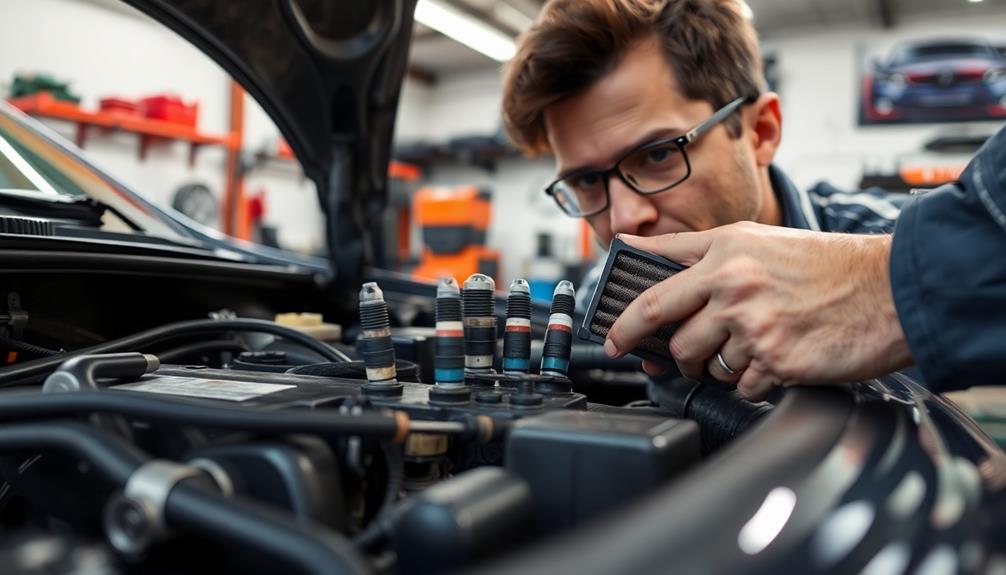
Keeping your car in prime condition is essential for avoiding those frustrating moments when it won't start. By following these preventative maintenance tips, you can guarantee your vehicle runs smoothly and reliably.
| Task | Frequency |
|---|---|
| Inspect battery terminals | Every 6 months |
| Check starter motor | Every 6 months |
| Replace fuel filter | Every 30,000 miles |
| Inspect ignition system | Every 6 months |
| Maintain timing belt | According to schedule |
Regularly inspect and clean your battery terminals to prevent corrosion, which can inhibit electrical connections. Schedule routine maintenance checks every six months to catch potential issues with the starter motor, alternator, and fuel system.
Don't forget to replace the fuel filter every 30,000 miles to maintain ideal fuel flow and engine performance. Additionally, make sure to check your ignition system components, including spark plugs and wires, to guarantee reliable starting performance.
Frequently Asked Questions
Why Is My Car Not Starting but It's Not the Battery?
If your car won't start but the battery's fine, check the starter motor for clicking sounds, verify there's fuel in the tank, and inspect for ignition issues or mechanical failures that could hinder engine function.
How Do I Know if It's My Battery or Alternator?
Think of your car as a symphony. If the lights dim and the music falters, it might be your battery. But if it starts and then fades, the alternator's your culprit. Check both!
What Does It Mean When My Car Won't Start but All the Lights Come On?
When your car won't start but all the lights come on, it likely points to issues with the starter motor, ignition system, or fuel delivery. Check for corroded terminals and verify you're in the correct gear.
Why Won't My Car Start Suddenly?
Imagine you're ready for work, but your car won't start suddenly. It could be a faulty starter; you hear clicking but no ignition. Check your fuel level or ignition switch to troubleshoot further.
Conclusion
So, the next time your car refuses to roar to life, don't just blame the battery! With a bit of detective work, you can uncover the real culprit lurking beneath the hood. Whether it's fuel issues, ignition troubles, or something else, tackling these problems can feel as intimidating as solving a Rubik's Cube blindfolded. Remember, if you're ever in doubt, don't hesitate to call in the pros. Keeping your ride in top shape is worth every ounce of effort!
